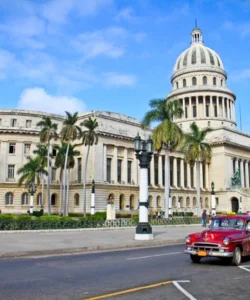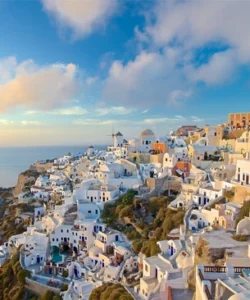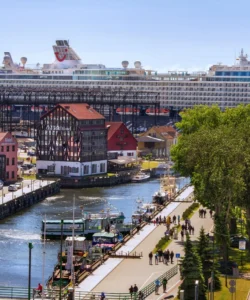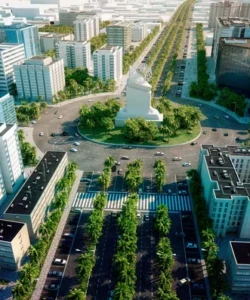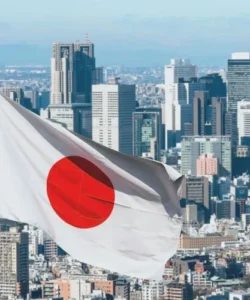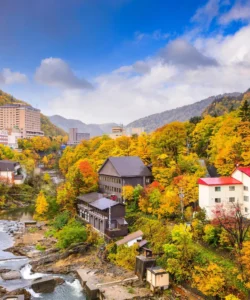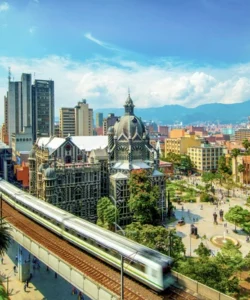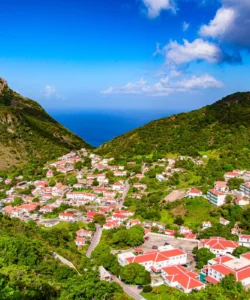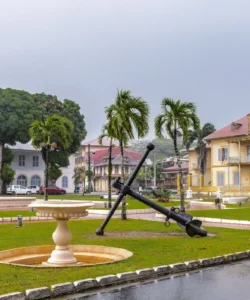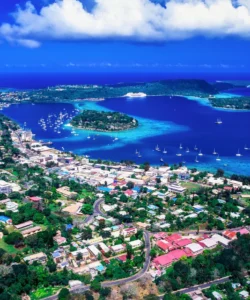Sweden, officially the Kingdom of Sweden, is a Nordic country in Northern Europe. It borders Norway to the west and north, and Finland to the east. It is connected to Denmark in the southwest by a bridge-tunnel across the Øresund Strait. Sweden is renowned for its vast forests, numerous lakes, archipelagos, innovative design, strong welfare state, and influential global brands.
Area: Approximately 450,295 square kilometers (173,860 sq mi). It is the largest country in Northern Europe by area.
Population: As of 2023, the population is estimated at around 10.5 million.
Language: The official language is Swedish, a North Germanic language closely related to Danish and Norwegian. Finnish and Sami are recognized minority languages. English is very widely spoken and understood throughout the country, particularly by younger generations and in urban areas.
Currency: The official currency is the Swedish Krona (SEK). While a member of the European Union, Sweden has not adopted the Euro.
Religion: The vast majority of Swedes are members of the Church of Sweden (Evangelical Lutheran), although active church attendance is generally low. There are also smaller communities of other Christian denominations, Muslims, and other faiths. A significant and growing portion of the population identifies as non-religious.
Capital: Stockholm is the capital and largest city of Sweden. Built on 14 islands connected by 57 bridges, it’s often called the “Venice of the North” and is known for its stunning beauty, historic Old Town, museums, and modern urban design.
Major Cities: Besides Stockholm, other significant cities include Gothenburg (Göteborg), Malmö, Uppsala, Linköping, Helsingborg, and Umeå.
Attractions & Wonders: Sweden offers a diverse range of attractions, from historic cities and cultural landmarks to vast wilderness areas:
- Stockholm:
- Gamla Stan (Old Town): A charming medieval district with narrow cobbled streets, colorful buildings, and the Royal Palace.
- Vasa Museum: Houses the remarkably preserved 17th-century warship Vasa, which sank on its maiden voyage.
- The Royal Palace (Kungliga slottet): The official residence of the Swedish monarch.
- Skansen Open-Air Museum: The world’s oldest open-air museum, showcasing traditional Swedish life and native Nordic animals.
- ABBA The Museum: An interactive museum dedicated to the legendary pop group.
- Djurgården: An island in central Stockholm offering museums, parks, and attractions.
- Gothenburg (Göteborg):
- Liseberg: One of Scandinavia’s largest and most popular amusement parks.
- Universeum: A large public science center.
- Haga: A charming old district with traditional wooden houses and cozy cafes.
- Malmö:
- Turning Torso: Scandinavia’s tallest skyscraper, a distinctive twisting residential building.
- Öresund Bridge: The impressive bridge-tunnel connecting Malmö with Copenhagen, Denmark.
- Malmöhus Castle: Scandinavia’s oldest surviving Renaissance castle.
- Swedish Lapland:
- Aurora Borealis (Northern Lights): Best observed in the northern parts of Sweden during winter months (September to April), particularly in places like Abisko National Park.
- Icehotel (Jukkasjärvi): The world’s first and largest hotel made entirely of ice and snow, rebuilt annually.
- Abisko National Park: Known for its “Blue Hole” (an area of clear sky) which makes it ideal for Northern Lights viewing, as well as hiking and Sami culture.
- Archipelagos:
- Stockholm Archipelago: Over 30,000 islands, islets, and skerries, perfect for island hopping, kayaking, and enjoying nature.
- West Coast Archipelago: Known for charming fishing villages, fresh seafood, and rocky landscapes.
- Visby, Gotland: A UNESCO World Heritage site, the best-preserved medieval city in Scandinavia, with impressive city walls and ruins.
- Drottningholm Palace: A UNESCO World Heritage site near Stockholm, the private residence of the Swedish Royal Family, with beautiful gardens.
- Dalarna: A region in central Sweden known for its traditional red wooden cottages, folk culture, and the Dala Horse.
Architecture: Swedish architecture is characterized by its blend of historical styles, functionalism, and a strong emphasis on clean lines, light, and natural materials.
- Medieval: Predominantly seen in Gamla Stan (Stockholm) and Visby, with stone churches and Hanseatic merchant houses.
- Baroque and Rococo: Evident in royal palaces (e.g., The Royal Palace in Stockholm) and grand manor houses.
- National Romanticism: Late 19th/early 20th-century style, incorporating elements of Swedish folklore and nature, often with brick and natural stone.
- Swedish Grace / Nordic Classicism: A brief but influential period in the 1920s, combining classical elements with modernist simplicity.
- Functionalism (Funkis): Became dominant from the 1930s onwards, emphasizing clean lines, practicality, and large windows to maximize light. This style is pervasive in Swedish urban planning and residential areas.
- Contemporary: Continues the legacy of functionalism and sustainability, with innovative and often minimalistic designs, a focus on energy efficiency, and a harmonious integration with the environment. Notable for timber construction and sustainable urban developments.
Roads: Sweden has an excellent and extensive road network. Highways (motorways/E-roads) connect all major cities and regions, and roads are generally well-maintained and clearly signposted. Driving is efficient, and traffic flows well outside of peak hours in major urban centers. Be prepared for winter driving conditions (snow and ice) from late autumn to early spring, particularly in the north.
Hotels: Sweden offers a wide range of accommodation options. In major cities like Stockholm, Gothenburg, and Malmö, you’ll find international hotel chains, numerous design-focused boutique hotels, and budget-friendly hostels. Unique accommodation experiences are popular, including ice hotels, treehouses, traditional cabins (stugor), and charming guesthouses in rural areas and archipelagos. There is a strong emphasis on design and sustainability in many Swedish hotels.
Restaurants: Swedish cuisine has traditionally been hearty and resourceful, adapted to the northern climate, but has undergone a significant modernization influenced by the “New Nordic Cuisine” movement.
- Stockholm and Gothenburg are culinary hotspots, offering fine dining, international cuisine, and trendy cafes, alongside traditional Swedish eateries.
- Traditional Swedish Dishes:
- Köttbullar (Meatballs): The iconic Swedish meatballs, typically served with lingonberry jam, mashed potatoes, and cream sauce.
- Smörgåsbord: A traditional Swedish buffet with various hot and cold dishes, including herring, salmon, charcuterie, and cheeses.
- Gravlax: Cured salmon, usually served with dill and mustard sauce.
- Sill (Herring): Pickled herring is a staple, especially for holidays.
- Räkmacka (Shrimp Sandwich): An open-faced sandwich piled high with shrimp.
- Kroppkakor: Potato dumplings filled with pork or bacon.
- Kanelbullar (Cinnamon Buns): A very popular pastry, often enjoyed with coffee (fika).
- Fika: Not a dish, but a quintessential Swedish tradition of taking a coffee break with a pastry or snack, often with friends or colleagues.
- Surströmming: Fermented Baltic Sea herring, a traditional dish known for its strong, pungent smell (an acquired taste!).
- Forest berries and mushrooms are widely used when in season, reflecting Sweden’s abundant natural resources.
- Modern Swedish cuisine emphasizes fresh, local, and seasonal ingredients, often foraging and incorporating wild game.
[envira-gallery id=”3997″]
